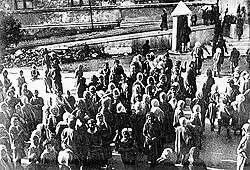
The Greco-Turkish War was a conflict which was fought between 1919 and 1922 as part of the wider Turkish War of Independence. The Turkish War of Independence was a conflict which developed as the Ottoman Empire, which had ruled Turkey, much of the Balkans and the Middle East since the sixteenth century, collapsed at the end of the First World War. As it collapsed numerous powers with which it had been at war since 1914 and neighboring states sought to take advantage of the situation to seize former Ottoman lands for themselves. Greece was one such power seeking to seize parts of Turkey. It had a strong claim to do so, as parts of western Turkey had been centers of Greek colonization and settlement going back to ancient times. Although initially successful, the Greek efforts broadly failed and the war ended with Turkey retaining control of the mainland. Under the terms of the Treaty of Lausanne which brought the Greco-Turkish War to an end approximately two million people were uprooted and moved between the two states in one of the largest population transfers in modern history.[1]
Greco-Turkish chronology of eventsGreco-Turkish chronology of events
In ancient times a number of different civilizations of the Mediterranean established colonies far and wide. For instance, the Phoenicians, based out of Syria and Lebanon, founded colonies as far afield as Tunisia, Morocco and Spain between the tenth and sixth centuries BCE. They were imitated and then eclipsed by the Greeks, who founded their own colonies in places like southern France, Italy, Sicily and the Crimea. However, no place experienced more intense colonization by the Greeks than the islands of the Aegean and the coastline of what was then known as Asia Minor but which we call Turkey today. Dozens of Greek cities and hundreds of smaller Greek settlements dotted western Turkey. Consequently, when the Ottoman Empire began to collapse in 1918 at the end of the First World War the Greeks had a stronger claim than most other nations to some of the territory once ruled by this vast empire.[2]

The Ottomans had once ruled over a vast territory stretching from Algeria to Iraq and from Hungary to Yemen. But it had lost over half its territory already by the time the First World War erupted in 1914, most recently owing to the Balkan Wars of 1912 and 1913. The First World War saw the rest of its territory in the Middle East overrun by the Arabs with British aid.[3] As the Ottoman state collapsed in 1919 others like Greece, Italy and Britain moved in to potentially gain further parts of the crumbling entity. Greece had been promised territory as a reward for its involvement in the First World War and now moved to secure it, sending forces to Smyrna in western Turkey in the summer of 1919. This was all partly related to the ‘Megali Idea’, the concept that an Orthodox Christian nation would resurrect the Byzantine Empire in the Balkans and Asia Minor by reclaiming extensive lands, and possibly even the city of Constantinople too, from the Muslim Turks. This form of irredentism fueled Greece’s decision to go to war with the Turks in 1919.[4]
The clash went well for the Greeks for most of it. By 1921 they were in control of much of western Turkey and were advancing eastwards towards Ankara, but they suffered defeat at the long Battle of the Sakarya in the early autumn of 1921 and thereafter the Turks rapidly pushed them back westwards towards the coast. A massive Turkish counterattack in 1922 eventually saw Smyrna recaptured and with this peace negotiations began. After extensive talks at the Swiss city of Lausanne, the Treaty of Lausanne was agreed to and signed in July 1923.[5]
Extent of migration after the Greco-Turkish WarExtent of migration after the Greco-Turkish War

The Treaty of Lausanne involved Greece agreeing to recognize the sovereignty of the new Turkish state that had emerged from the Ottoman Empire, while also confirming the borders of the new nation, which broadly follow the borders of modern-day Turkey. Disputes concerning the many islands of the Aegean Sea and the Hellespont were also resolved, nearly entirely in favor of Greece, though it failed to acquire any territory on the coastline of Turkey. In this sense the war was a failure for Greece. What this meant was that the millions of people of Greek Orthodox Christian heritage and ethnicity who lived within Turkey were not to become part of a wider Greek state. As a result, in early 1923 the Greeks and Turks had already reached an agreement whereby they would engage in a major population transfer whereby hundreds of thousands of Muslims living in Greece would move to Turkey, while the even larger number of Greek Orthodox Christians in Turkey would relocate to Greece.[6]
Demographic impact of the Greco-Turkish WarDemographic impact of the Greco-Turkish War
The population transfers commenced tenuously in 1923 and continued for several years thereafter. The number of people involved was huge. There were at least 1.6 million inhabitants of the two countries uprooted and it may have been closer to two million. Approximately three-quarters of those involved were Greek Orthodox Christians who arrived to Greece. This arrival of between 1.2 and 1.4 million people from Thrace, Anatolia and other parts of Turkey was a massive population boon to Greece, which only had about five million inhabitants at the time. Perhaps 400,000 to 500,000 Muslims moved in the other direction from Greece to Turkey. The population transfers were based nearly entirely on religion and had the effect of creating more religiously homogenous countries, particularly so in Greece where the Muslim minority that had constituted upwards of 10% of the population nearly completely disappeared.[7]
See alsoSee also
Explore more about the Greco-Turkish WarExplore more about the Greco-Turkish War
- Greece, Asia Minor Refugees, 1914-1923 record collection on MyHeritage
- Greece’s Top 5 Types of Genealogy Records at Legacy Family Tree Webinars
- Turkey-Greece population exchange still painful for those yearning for a lost past at Middle East Eye
References
- ↑ Peter Kincaid Jensen, ‘The Greco-Turkish War, 1920-1922’, in International Journal of Middle East Studies, Vol. 10, No. 4 (Nov., 1979), pp. 553–565.
- ↑ https://www.worldhistory.org/Greek_Colonization/
- ↑ https://www.nam.ac.uk/explore/egypt-and-palestine-campaign
- ↑ Michael Finefrock, ‘Ataturk, Lloyd George and the Megali Idea: Cause and Consequence of the Greek Plan to Seize Constantinople from the Allies, June-August 1922’, in The Journal of Modern History, Vol. 52, No. 1 (March, 1980).
- ↑ https://origins.osu.edu/milestones/may-2019-greco-turkish-war-smyrna-sakarya-kemal-ottoman?language_content_entity=en
- ↑ https://www.dw.com/en/greece-and-turkey-the-treaty-of-lausanne-100-years-on/a-66307830
- ↑ https://merip.org/2013/06/the-greek-turkish-population-exchange/

